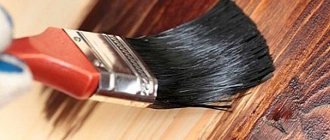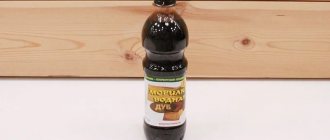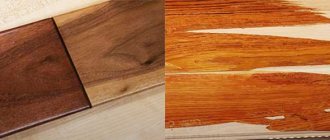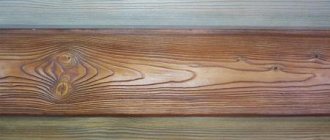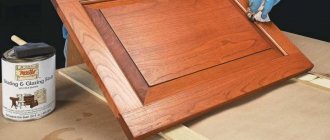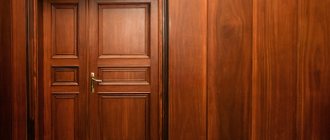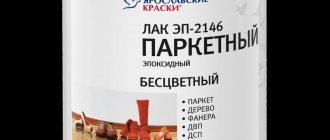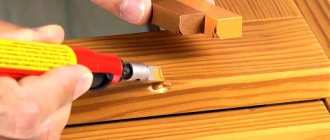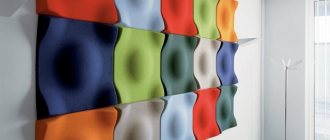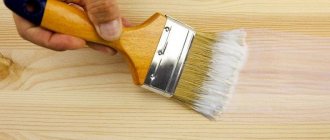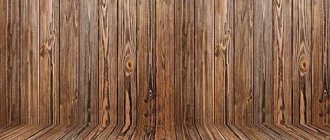Wood, under the influence of negative factors, over time loses its natural attractiveness and deteriorates its performance characteristics: it fades under the influence of UV; deformed from excess moisture; rot when pathogenic microflora multiply.
To give a rich shade, preserve the structure, protect against destruction and extend service life , a special wood stain is used. Read more about what types of compositions there are, how to prepare them and what are the features of processing wooden surfaces.
Types of wood stains
The stain, which forms a thick layer, is suitable for application to perfectly dry wood with a maximum humidity of 12-17%. Heavy-duty stain is suitable for structural elements that do not change their dimensions significantly during their service life depending on humidity and temperature.
High build stain is suitable for:
- Window shutters;
- Doors;
- Wooden cladding of the facade of the house;
- Roof cladding, etc.
This stain is thicker, less absorbed into the wood and contains more dry substances, which form a transparent film after drying. on a wooden surface.
The layer of such stain on the surface of the wood is much smaller than that of varnish or paint; the natural grain of the wood is emphasized and immediately catches the eye.
Thin layer
Thin-layer stain is less dense and contains less dry matter compared to thick-layer stain. This means that the thin-layer stain penetrates deep into the wood and leaves virtually no protective film on the surface.
- It is generally suitable for application to wood that is not completely dry and therefore has a higher moisture content.
- It is suitable, for example, for garden furniture, fences, garden houses and all other structures made of damp wood.
- If you use a thick layer of stain, expect it to peel off.
Medium layer
Medium-layer stain forms a transition between thin-layer and thick-layer. It is more suitable for dry wood, suitable for windows, doors, wood cladding facades, formwork, garden furniture, etc.
Hybrid
Hybrid stain is a thick layer containing hybrid molecules that form a flexible and breathable membrane. The stain is deeply absorbed into the wood, protecting it from damage by mold and mildew, exposure to adverse weather conditions and UV radiation.
Suitable for almost all wooden surfaces, exterior and interior.
Formation of stains during staining and how to avoid it
Such a flaw appears due to the unevenness of the wood structure; the stain may not penetrate the surface equally deeply everywhere. As a result, individual stains may remain on the base; to avoid this, you need to use a special conditioner. It is applied as the first layer and closes the pores, the next layer is a gel that does not spread.
Individual stains may remain on the base; to avoid this, you need to use a special conditioner.
Stain Basics
Synthetics are a standard, long-used dye composition. The stain does not have such stringent requirements for the readiness of the base as stains with a water-soluble base.
In principle, there is no need to dilute the stains, but to clean with a brush you already need a synthetic solvent.
- Water-soluble acrylic base is an ecological type of stain. Application is very easy, dries faster, has no odor, and tools are easy to clean.
- However, some professionals avoid acrylate-based stains because they require a perfectly clean and grease-free base.
- Some also argue that water-soluble stains do not blend well with the wood and do not create a uniform finish.
Dry matter content
This is a relatively important parameter, but it can only be tracked in the product passport. For a non-professional, this parameter is not so important. The dry matter content of the product is indicated in%.
The higher the dry matter content, the thicker the protective film will form on the wooden surface after the stain dries.
In the case of thin-layer options, the dry matter content is about 20-30%, in the case of thick-layer stains - about 55-65%.
Defects and their elimination
Staining wooden furniture must be done extremely carefully, otherwise there is a high risk of defects forming that are quite difficult to eliminate. But if you know how to get rid of them correctly, then there shouldn’t be any problems.
The main defect is the formation of streaks. They arise as a result of applying a large amount of the mixture and its subsequent rapid drying. In this case, it is necessary to remove the layer of impregnation applied to the wood, then apply a new layer on it, which will soften it, and then remove excess impregnation with a rag.
After the wood stain has completely dried, it can be removed using paint solvents. Before this, the top layer is removed with sandpaper or a plane, since the solvent is not able to remove all the pigment.
You can choose a special remover that will remove the excess layer of coating impregnation from the wood. You can use a hair dryer in combination with a scraper and brush - sometimes this is better than washing.
The most difficult defect is spotting of the product. To remove it, the painted area is treated with a plane (this defect is not washed off with a solvent). In plywood, all face veneer must be removed. To avoid staining, it is better to use a gel stain or first apply a test layer on an unwanted piece of wood to see how the coating behaves on the desired surface. It is worth remembering that the impregnation must be stored in a place away from children.
How to apply stain (2 videos)
Products of different brands (30 photos)
How to properly apply stain to wood
Priority number one is a properly prepared base.
She must be:
- Clean;
- Polished;
- Low fat;
- Cleared of dust.
If you are staining a surface that has previously been painted, you should check the condition of the original paint. If it's hard, sticky, and doesn't peel or crack, just peel it off and sand it gently with sandpaper.
If the paint is peeling or cracking, it must be removed carefully. Then the base must be sanded and cleaned of large chips and dust particles.
It is important that the moisture content of the wood does not exceed the maximum permissible value, otherwise the stain may peel off.
Before applying stain, it is recommended to apply a fungicidal impregnating agent, which will prevent blueing of the wood or damage to the wood by a fungus that destroys the wood.
- However, there are also stains on the market that have both decorative and protective properties. The stain must be mixed thoroughly so that no sediment remains at the bottom of the container. Seal any unused remainder to prevent it from drying out.
- The composition is applied to the wooden surface with a soft brush in the direction of the wood grain. The optimal temperature for application is 10-30 ° C. The stain is applied in at least 2-3 layers, with the interval between individual layers being at least 5-7 hours.
It is impossible to standardize the exact conditions for applying stain. It is always necessary to study the stain application instructions or product data sheet, where you can read everything that is important, from preparing the base to finishing the stain surface.
What to consider when choosing?
The following factors will help you decide:
- Purpose. There are products for external and internal work, with varying degrees of health safety, covering power and coloring results.
- Additional options. We are talking about protective properties and visual effects: mother of pearl, frost, patina.
- Type of wood. For soft conifers, wax, acrylic and oil stains are preferred, which apply evenly.
- Consumption. It is always indicated on the packaging. If there is a large area to be processed, the issue of economy comes to the fore.
- Color code. It is standard, for example: “walnut”, “cherry”, “mahogany”, but the shades from different manufacturers differ, so it is better to purchase the stain you like with a reserve.
The most common mistakes
If the wood is not completely dry, it is not recommended to cover it with a thick layer; the stain may peel off over time. If necessary, use a thin layer of stain that absorbs into the wood and does not leave an airtight film on the surface.
- If you are treating wood outdoors, make sure the stain is rated for that purpose and has a UV filter to prevent the wood from blackening or graying.
- Lighter shades have a lower pigment content, which protects the wood from unwanted discoloration, while shades that are too dark accumulate heat better, changing their volume and are more susceptible to cracking.
Controlling air humidity is also suitable for applying thick build stain. If the composition is applied in high humidity, the surface of the stain may become dull soon after application. Therefore, it is recommended to apply stain early in the morning when air humidity is lowest.
Creating effects
Alcohol or water stain can create an imitation of the naturalness of the coating without obvious traces of processing. When choosing a material for protection and painting, focus on the desired effect: choose a shade of oak, pine or ebony (as in the photo) - the interior will instantly be ennobled.
Products made from ash or oak do not need to be tinted - leave their structure and shade open, choosing the shade of this species that is as close to nature as possible.
Properly stained wood should retain its natural appearance. Only acrylic or wax stains stand out, the color range of which goes beyond naturalness.
The properties of each type of wood are different. In order not to make a mistake when purchasing, pay attention to the flower palette: the composition is applied to planks of different types, where you can see the final result.
Calculation of the amount of stain
Before you go to the store to buy stain, calculate how much you need. Each jar displays the consumption of stain, in other words, how many m2 of 1 liter of stain is used.
The value is given within a certain range, but it is always recommended to stick to the lower limit. It may happen that the wood you stain will be too absorbent and therefore the consumption will be higher.
Also keep in mind that you will likely be applying more coats of stain. Thus, if, according to the manufacturer, the spray can is enough for at least 15 m2, and you apply 3 layers of glaze, in fact it will only be enough for 5 m2.
Manufacturers
Choosing a quality product to protect and add a decorative layer to wood is difficult, because there are a large number of products on sale from different brands. But still, some brands stand out among others, and buyers purchase them more often:
- German manufacturers - Caparol, Dufa, Flamingo;
- Turkish brands - Betek, Dyo and Marshal;
- There are also companies from Slovenia that are beginning to actively conquer the construction market, thanks to their high quality - Hellios and Belinka Belles DO O;
- Among Russian companies, Novbytkhim stains stand out.
Staining wooden bases gives high-quality results in protecting structures from various external influences that can lead to destruction of the material.
Staining wooden bases gives high-quality results in protecting structures from various external influences that can lead to destruction of the material. But they also help improve decorative properties by changing the shade of the base. Thanks to the variety of products, you can choose an option for any operating conditions.
